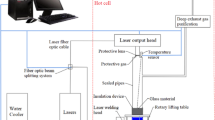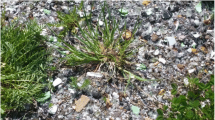Abstract
A safe and efficient method is necessary for the treatment of high-level liquid waste (HLLW). Therefore, we propose for the first time the use of laser to simulate the glass curing of HLLW. In this paper, borosilicate glasses containing 16% simulated oxides were successfully sintered by laser at different temperatures (1050 °C–1200 °C). A series of properties of the obtained cured bodies were analyzed. The results show that the cured body can be prepared above 1100 °C to meet the requirements. This demonstrates the potential application of lasers in the treatment of HLLW glass curing.










Similar content being viewed by others
References
Orlova AI (2022) Crystalline phosphates for HLW immobilization-composition, structure, properties and production of ceramics. Spark plasma sintering as a promising sintering technology. J Nucl Mater 559:153407. https://doi.org/10.1016/j.jnucmat.2021.153407
Bonnet J, Mosser-Ruck R, Sterpenich J et al (2022) Chemical and mineralogical characterizations of a low-pH cementitious material designed for the disposal cell of the high-level radioactive waste (HLW). Cem Concr Res 162:107013. https://doi.org/10.1016/j.cemconres.2022.107013
Rigby JC, Dixon DR, Kloužek J et al (2023) Alternative reductants for foam control during vitrification of high-iron high level waste (HLW) feeds. J Non-Cryst Solids 608:122240. https://doi.org/10.2139/ssrn.4241787
Verhoeven B, Bogaerts W, Van Aken P et al (2022) (2022) Pitting and general corrosion susceptibilities of materials for high level radioactive waste (HLW) disposal. Materials 15(18):6464. https://doi.org/10.3390/ma15186464
Lago DC, Sánchez AD, Prado MO (2022) Immobilization of a simulated high-level waste in an yttrium aluminosilicate glass. Self-heating assessment. J Eur Ceram Soc 42(16):7561–7569. https://doi.org/10.1016/j.jeurceramsoc.2022.08.048
Jantzen CM, Lee WE, Ojovan MI (2013) Radioactive waste conditioning, immobilization, and encapsulation processes and technologies: overview and advances. In: Jantzen Radioactive waste management and contaminated site clean-up: processes, technologies and international experience. Woodhead Publishing, Cambridge
Fuks L, Herdzik-Koniecko I, Kiegiel K et al (2022) Methods of thermal treatment of radioactive waste. Energies 15(1):375. https://doi.org/10.3390/en15010375
Skrigan IN, Lopukh DB, Vavilov AV et al (2022) A numerical study of sedimentation of noble metals during vitrification of high-level waste using cold hearth melting. Russ Electr Engin 93(3):162–167. https://doi.org/10.3103/S1068371222030129
Crum J, Maio V, McCloy J et al (2014) Cold crucible induction melter studies for making glass ceramic waste forms: a feasibility assessment. J Nucl Mater 444(1–3):481–492. https://doi.org/10.1016/j.jnucmat.2013.10.029
Quazi MM, Ishak M, Fazal MA et al (2020) Current research and development status of dissimilar materials laser welding of titanium and its alloys. Opt Laser Technol 126:106090. https://doi.org/10.1016/j.optlastec.2020.106090
Tan C, Weng F, Sui S et al (2021) Progress and perspectives in laser additive manufacturing of key aeroengine materials. Int J Mach Tool Manu 170:103804. https://doi.org/10.1016/j.ijmachtools.2021.103804
Mizzi L, Salvati E, Spaggiari A et al (2020) Highly stretchable two-dimensional auxetic metamaterial sheets fabricated via direct-laser cutting. Int J Mech Sci 167:105242. https://doi.org/10.1016/j.ijmecsci.2019.105242
Fiocchi J, Tuissi A, Biffi CA (2021) Heat treatment of aluminium alloys produced by laser powder bed fusion: a review. Mater Des 204:109651. https://doi.org/10.1016/j.matdes.2021.109651
Goel A, McCloy JS, Pokorny R et al (2019) Challenges with vitrification of Hanford High-Level Waste (HLW) to borosilicate glass–an overview. J Non-Cryst Solids X4:100033. https://doi.org/10.1016/j.nocx.2019.100033
Yu S, Liu L, Han L et al (2022) Ultra-high power laser for vitrification of borosilicate glass. AIP Adv 12(9):095211. https://doi.org/10.1063/5.0102864
Sun J, Liu L, Han L et al (2022) 100 kW ultra high power fiber laser. Opt Continuum 1(9):1932–1938. https://doi.org/10.1364/OPTCON.465836
ASTM International (2014) Standard test methods for determining chemical durability of nuclear, hazardous, and mixed waste glasses and multiphase glass ceramics: the product consistency test (PCT), West Conshohocken, PA
Lucacel RC, Radu T, Tătar AS et al (2014) The influence of local structure and surface morphology on the antibacterial activity of silver-containing calcium borosilicate glasses. J Non-Cryst Solids 404:98–103. https://doi.org/10.1016/j.jnoncrysol.2014.08.004
El-Damrawi G, El-Egili K (2001) Characterization of novel CeO2–B2O3 glasses, structure and properties. Physica B 299(1–2):180–186. https://doi.org/10.1016/S0921-4526(00)00593-7
Lai Y, Zeng Y, Tang X et al (2016) Structural investigation of calcium borosilicate glasses with varying Si/Ca ratios by infrared and Raman spectroscopy. RSC Adv 6(96):93722–93728. https://doi.org/10.1039/C6RA20969F
Doweidar H, Saddeek YB (2010) Effect of La2O3 on the structure of lead borate glasses. J Non-Cryst Solids 356(28–30):1452–1457. https://doi.org/10.1016/j.jnoncrysol.2010.04.036
Mansour E (2011) Structure and electrical conductivity of new Li2O–CeO2–B2O3 glasses. J Non-Cryst Solids 357(5):1364–1369. https://doi.org/10.1016/j.jnoncrysol.2010.09.026
Tan S, Ojovan MI, Hyatt NC et al (2015) MoO3 incorporation in magnesium aluminosilicate glasses. J Nucl Mater 458:335–342. https://doi.org/10.1016/j.jnucmat.2014.11.069
Brehault A, Patil D, Kamat H et al (2018) Compositional dependence of solubility/retention of molybdenum oxides in aluminoborosilicate-based model nuclear waste glasses. J Phys Chem B 122(5):1714–1729. https://doi.org/10.1021/acs.jpcb.7b09158
Zhang S, Ding Y, Lu X et al (2016) Rapid and efficient disposal of radioactive contaminated soil using microwave sintering method. Mater Lett 175:165–168. https://doi.org/10.1016/j.matlet.2016.04.018
Min BY, Kang Y, Song PS et al (2007) Study on the vitrification of mixed radioactive waste by plasma arc melting. J Ind Eng Chem 13(1):57–64
Yan H, Chen Q, Zhang G et al (2020) Reevaluating the efficacy of moderate annealing in nuclear waste vitrification for sustainable high-level waste management. J Cleaner Prod 268:122155. https://doi.org/10.1016/j.jclepro.2020.122155
Acknowledgements
This work was supported by the Wuhan Municipal Science and Technology Major Project (Grant No. 2021012002023424). The authors also acknowledge Wuhan Raycus Fiber Laser Technologies Co. Ltd. for the 100 kW CW fiber laser and China Building Materials Academy for borosilicate glass beads.
Author information
Authors and Affiliations
Corresponding author
Additional information
Publisher's Note
Springer Nature remains neutral with regard to jurisdictional claims in published maps and institutional affiliations.
Rights and permissions
Springer Nature or its licensor (e.g. a society or other partner) holds exclusive rights to this article under a publishing agreement with the author(s) or other rightsholder(s); author self-archiving of the accepted manuscript version of this article is solely governed by the terms of such publishing agreement and applicable law.
About this article
Cite this article
Yu, S., Ling, K., Zhang, J. et al. Vitrification of simulated high-level liquid waste by laser. J Radioanal Nucl Chem 332, 3733–3740 (2023). https://doi.org/10.1007/s10967-023-09065-2
Received:
Accepted:
Published:
Issue Date:
DOI: https://doi.org/10.1007/s10967-023-09065-2




